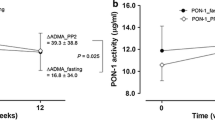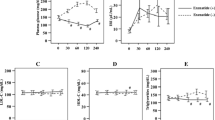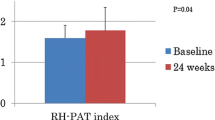Abstract
Postprandial hypertriglyceridemia and hyperglycemia may promote endothelial and hemorheological dysfunction. The present study investigated the effects of pravastatin on endothelial function and hemorheology in patients with stable angina pectoris (AP) before and after eating a test meal. We recruited 26 patients with stable AP who had impaired glucose tolerance and mild dyslipidemia and six healthy men as controls to assess endothelial function and hemorheological behavior. In each group, we measured forearm blood flow (FBF) during post-ischemic reactive hyperemia and obtained blood samples before and 2 h after the test meal. Pravastatin 20 mg/day was then commenced in the 26 AP patients. The above tests were repeated after 2 days and 6 months. Maximum FBF during hyperemia in the baseline fasting phase was significantly lower in the AP patients than in the controls (p < 0.05). Fasting and postprandial FBF during reactive hyperemia time-dependently improved after pravastatin treatment (p < 0.05 vs. baseline data for each phase). Pravastatin treatment for 6 months, but not for 2 days, inhibited leukocyte activation and improved hemorheological parameters. In conclusion, pravastatin treatment for 6 months improved fasting and postprandial endothelial and hemorheological dysfunction in AP patients.




Similar content being viewed by others
References
McNamara JR, Shah PK, Nakajima K, Cupples LA, Wilson PW, Ordovas JM, Schaefer EJ (2001) Remnant-like particle (RLP) cholesterol is an independent cardiovascular disease risk factor in women: results from the Framingham Heart Study. Atherosclerosis 154(1):229–236
Ginsberg HN, Jones J, Blaner WS, Thomas A, Karmally W, Fields L, Blood D, Begg MD (1995) Association of postprandial triglyceride and retinyl palmitate responses with newly diagnosed exercise-induced myocardial ischemia in middle-aged men and women. Arterioscler Thromb Vasc Biol 15(11):1829–1838
Gotto AM Jr (1998) Triglyceride: the forgotten risk factor. Circulation 97(11):1027–1028
Kugiyama K, Doi H, Motoyama T, Soejima H, Misumi K, Kawano H, Nakagawa O, Yoshimura M, Ogawa H, Matsumura T, Sugiyama S, Nakano T, Nakajima K, Yasue H (1998) Association of remnant lipoprotein levels with impairment of endothelium-dependent vasomotor function in human coronary arteries. Circulation 97(25):2519–2526
DECODE study group; European Diabetes Epidemiology Group (1998) Will new diagnostic criteria for diabetes mellitus change phenotype of patients with diabetes? Reanalysis of European epidemiological data. DECODE Study Group on behalf of the European Diabetes Epidemiology Study Group. BMJ 317(7155):371–375
DECODE study group; European Diabetes Epidemiology Group (1999) Glucose tolerance and mortality: comparison of WHO and American Diabetes Association diagnostic criteria. The DECODE study group. European Diabetes Epidemiology Group. Diabetes Epidemiology: Collaborative analysis Of Diagnostic criteria in Europe. Lancet 354(9179):617–621
DECODE study group (2002) Cardiovascular risk profile assessment in glucose-intolerant Asian individuals—an evaluation of the World Health Organization two-step strategy: the DECODA Study (Diabetes Epidemiology: Collaborative Analysis of Diagnostic Criteria in Asia). Diabet Med 19(7):549–557
Nakagami T; DECODA Study Group (2004) Hyperglycaemia and mortality from all causes and from cardiovascular disease in five populations of Asian origin. Diabetologia 47(3):385–394
Tominaga M, Eguchi H, Manaka H, Igarashi K, Kato T, Sekikawa A (1999) Impaired glucose tolerance is a risk factor for cardiovascular disease, but not impaired fasting glucose. The funagata diabetes study. Diabetes Care 22(6):920–924
Raitakari OT, Lai N, Griffiths K, McCredie R, Sullivan D, Celermajer DS (2000) Enhanced peripheral vasodilation in humans after a fatty meal. J Am Coll Cardiol 36(2):417–422
Vogel RA, Corretti MC, Plotnick GD (1997) Effect of a single high-fat meal on endothelial function in healthy subjects. Am J Cardiol 79(3):350–354
Gudmundsson GS, Sinkey CA, Chenard CA, Stumbo PJ, Haynes WG (2000) Resistance vessel endothelial function in healthy humans during transient postprandial hypertriglyceridemia. Am J Cardiol 85(3):381–385
Bae JH, Bassenge E, Lee HJ, Park KR, Park CG, Park KY, Lee MS, Schwemmer M (2001) Impact of postprandial hypertriglyceridemia on vascular responses in patients with coronary artery disease: effects of ACE inhibitors and fibrates. Atherosclerosis 158(1):165–171
Lundman P, Eriksson MJ, Stühlinger M, Cooke JP, Hamsten A, Tornvall P (2001) Mild-to-moderate hypertriglyceridemia in young men is associated with endothelial dysfunction and increased plasma concentrations of asymmetric dimethylarginine. J Am Coll Cardiol 38(1):111–116
Gokce N, Duffy SJ, Hunter LM, Keaney JF, Vita JA (2001) Acute hypertriglyceridemia is associated with peripheral vasodilation and increased basal flow in healthy young adults. Am J Cardiol 88(2):153–159
Bae JH, Bassenge E, Kim KB, Kim YN, Kim KS, Lee HJ, Moon KC, Lee MS, Park KY, Schwemmer M (2001) Postprandial hypertriglyceridemia impairs endothelial function by enhanced oxidant stress. Atherosclerosis 155(2):517–523
Katz DL, Nawaz H, Boukhalil J, Giannamore V, Chan W, Ahmadi R, Sarrel PM (2001) Acute effects of oats and vitamin E on endothelial responses to ingested fat. Am J Prev Med 20(2):124–129
Marchesi S, Lupattelli G, Schillaci G, Pirro M, Siepi D, Roscini AR, Pasqualini L, Mannarino E (2000) Impaired flow-mediated vasoactivity during post-prandial phase in young healthy men. Atherosclerosis 153(2):397–402
Feldman CL, Stone PH (2000) Intravascular hemodynamic factors responsible for progression of coronary atherosclerosis and development of vulnerable plaque. Curr Opin Cardiol 15(6):430–440
Kikuchi Y, Sato K, Mizuguchi Y (1994) Modified cell-flow microchannels in a single-crystal silicon substrate and flow behavior of blood cells. Microvasc Res 47(1):126–139
Kikuchi Y (1995) Effect of leukocytes and platelets on blood flow through a parallel array of microchannels: micro- and macroflow relation and rheological measures of leukocyte and platelet activities. Microvasc Res 50(2):288–300
Ridker PM, Rifai N, Pfeffer MA, Sacks F, Braunwald E (1999) Long-term effects of pravastatin on plasma concentration of C-reactive protein. The Cholesterol and Recurrent Events (CARE) Investigators. Circulation 100(3):230–235
Lacoste L, Lam JY, Hung J, Letchacovski G, Solymoss CB, Waters D (1995) Hyperlipidemia and coronary disease. Correction of the increased thrombogenic potential with cholesterol reduction. Circulation 92(11):3172–3177
Tsuda Y, Satoh K, Kitadai M, Takahashi T, Izumi Y, Hosomi N (1996) Effects of pravastatin sodium and simvastatin on plasma fibrinogen level and blood rheology in type II hyperlipoproteinemia. Atherosclerosis 122(2):225–233
Dajani EZ, Shahwan TG, Dajani NE (2002) Statins, platelet aggregation and coronary heart disease. J Assoc Acad Minor Phys 13(1):27–31
Salonen R, Nyssönen K, Porkkala-Sarataho E, Salonen JT (1995) The Kuopio Atherosclerosis Prevention Study (KAPS): effect of pravastatin treatment on lipids, oxidation resistance of lipoproteins, and atherosclerotic progression. Am J Cardiol 76(9):34 C-39 C
Arao K, Yasu T, Umemoto T, Jinbo S, Ikeda N, Ueda S, Kawakami M, Momomura S (2009) Effects of pitavastatin on postprandial endothelial function, oxidative stress, and hemorheology in patients with stable angina pectoris. Circ J 73:1523–1530
Egashira K, Hirooka Y, Kai H, Sugimachi M, Suzuki S, Inou T, Takeshita A (1994) Reduction in serum cholesterol with pravastatin improves endothelium-dependent coronary vasomotion in patients with hypercholesterolemia. Circulation 89(6):2519–2524
Iijima R, Ndrepepa G, Kujath V, Harada Y, Kufner S, Schunkert H, Nakamura M, Kastrati A (2016) A pan-coronary artery angiographic study of the association between diabetes mellitus and progression or regression of coronary atherosclerosis. Heart Vessels. doi:10.1007/s00380-016-0889-8
Okumura K, Tsukamoto H, Tsuboi H, Hirayama H, Kamiya H, Watarai M, Ishiki R, Murohara T; Samurai Study Investigators (2015) High HDL cholesterol level after treatment with pitavastatin is an important factor for regression in carotid intima-media thickness. Heart Vessels 30(2):154–161
Nozue T, Yamamoto S, Tohyama S, Fukui K, Umezawa S, Onishi Y, Kunishima T, Sato A, Nozato T, Miyake S, Takeyama Y, Morino Y, Yamauchi T, Muramatsu T, Hibi K, Terashima M, Michishita I (2015) Comparison of the effects of pitavastatin versus pravastatin on coronary artery plaque phenotype assessed by tissue characterization using serial virtual histology intravascular ultrasound. Heart Vessels 30(1):36–44
Nakamura H, Arakawa K, Itakura H, Kitabatake A, Goto Y, Toyota T, Nakaya N, Nishimoto S, Muranaka M, Yamamoto A, Mizuno K, Ohashi Y; MEGA Study Group (2006) Primary prevention of cardiovascular disease with pravastatin in Japan (MEGA Study): a prospective randomised controlled trial. Lancet 368(9542):1155–1163
Higashi Y, Sasaki S, Sasaki N, Nakagawa K, Ueda T, Yoshimizu A, Kurisu S, Matsuura H, Kajiyama G, Oshima T (1999) Daily aerobic exercise improves reactive hyperemia in patients with essential hypertension. Hypertension 33:591–597
Fukuda S, Yasu T, Predescu DN, Schmid-Schönbein GW (2000) Mechanisms for regulation of fluid shear stress response in circulating leukocytes. Circ Res 86(1):E13–E18
Fukuda S, Yasu T, Kobayashi N, Ikeda N, Schmid-Schönbein GW (2004) Contribution of fluid shear response in leukocytes to hemodynamic resistance in the spontaneously hypertensive rat. Circ Res 95(1):100–108
Zhao SP, Liu L, Gao M, Zhou QC, Li YL, Xia B (2001) Impairment of endothelial function after a high-fat meal in patients with coronary artery disease. Coron Artery Dis 12(7):561–565
Strey CH, Young J, Collier M, Florkowski CM, Shand BI, Scott RS (2004) The postprandial state does not impair endothelial function in women with type 2 diabetes, irrespective of glycaemic control. Diabetologia 47(10):1838–1846
Muntwyler J, Sütsch G, Kim JH, Schmid H, Follath F, Kiowski W, Amann FW (2001) Post-prandial lipaemia and endothelial function among healthy men. Swiss Med Wkly 131(15–16):214–218
Brun JF (2002) Hormones, metabolism and body composition as major determinants of blood rheology: potential pathophysiological meaning. Clin Hemorheol Microcirc 26(2):63–79
Fukuda I, Yoshida T, Yoritsune H, Kiso T, Konishi S, Kawasaki T, Mozai T (1978) Studies on the hemorheological factors in ischemic heart disease and cerebrovascular disorders. Bull Osaka Med Sch 24(2):83–91
Otto C, Pschierer V, Soennichsen AC, Schwandt P, Richter WO (1997) Postprandial hemorheology and apolipoprotein B metabolism in patients with familial hypertriglyceridemia. Metabolism 46(11):1299–1304
Kurihara T, Deguchi S, Kato J, Furakawa M, Tsuchiya M, Akimoto M, Ishiguro H, Hashimoto H, Niimi A, Maeda A, Shigemoto M, Yamashita K, Kawakami A, Umemura K, Nakashima M, Nakano T, Saniabadi AR (2001) Impaired blood rheology by remnant-like lipoprotein particles: studies in patients with fatty liver disease. Clin Hemorheol Microcirc 24(4):217–225
Hernández-Perera O, Pérez-Sala D, Navarro-Antolín J, Sánchez-Pascuala R, Hernández G, Díaz C, Lamas S (1998) Effects of the 3-hydroxy-3-methylglutaryl-CoA reductase inhibitors, atorvastatin and simvastatin, on the expression of endothelin-1 and endothelial nitric oxide synthase in vascular endothelial cells. J Clin Invest 101(12):2711–2719
Kureishi Y, Luo Z, Shiojima I, Bialik A, Fulton D, Lefer DJ, Sessa WC, Walsh K (2000) The HMG-CoA reductase inhibitor simvastatin activates the protein kinase Akt and promotes angiogenesis in normocholesterolemic animals. Nat Med 6(9):1004–1010
Omori H, Nagashima H, Tsurumi Y, Takagi A, Ishizuka N, Hagiwara N, Kawana M, Kasanuki H (2002) Direct in vivo evidence of a vascular statin: a single dose of cerivastatin rapidly increases vascular endothelial responsiveness in healthy normocholesterolaemic subjects. Br J Clin Pharmacol 54(4):395–399
Wilmink HW, Twickler MB, Banga JD, Dallinga-Thie GM, Eeltink H, Erkelens DW, Rabelink TJ, Stroes ES (2001) Effect of statin versus fibrate on postprandial endothelial dysfunction: role of remnant-like particles. Cardiovasc Res 50(3):577–582
Ceriello A, Taboga C, Tonutti L, Quagliaro L, Piconi L, Bais B, Da Ros R, Motz E (2002) Evidence for an independent and cumulative effect of postprandial hypertriglyceridemia and hyperglycemia on endothelial dysfunction and oxidative stress generation: effects of short- and long-term simvastatin treatment. Circulation 106(10):1211–1218
Salonen R, Nyyssönen K, Porkkala E, Rummukainen J, Belder R, Park JS, Salonen JT (1995) Kuopio Atherosclerosis Prevention Study (KAPS). A population-based primary preventive trial of the effect of LDL lowering on atherosclerotic progression in carotid and femoral arteries. Circulation 92(7):1758–1764
Hayek T, Kaplan M, Kerry R, Aviram M (2007) Macrophage NADPH oxidase activation, impaired cholesterol fluxes, and increased cholesterol biosynthesis in diabetic mice: a stimulatory role for d-glucose. Atherosclerosis 195(2):277–286
Lowe G, Rumley A, Norrie J, Ford I, Shepherd J, Cobbe S, Macfarlane P, Packard C (2000, 2001) Blood rheology, cardiovascular risk factors, and cardiovascular disease: the West of Scotland coronary prevention study. Thromb Haemost 84(4):553–558. Erratum in: Thromb Haemost 85(5):946
Di Garbo V, Bono M, Di Raimondo D, De Simone R, Raneli G, Avellone G (2000) Non lipid, dose-dependent effects of pravastatin treatment on hemostatic system and inflammatory response. Eur J Clin Pharmacol 56(4):277–284
Dupuis J, Tardif JC, Cernacek P, Théroux P (1999) Cholesterol reduction rapidly improves endothelial function after acute coronary syndromes. The RECIFE (reduction of cholesterol in ischemia and function of the endothelium) trial. Circulation 99(25):3227–3233
Acknowledgements
The authors wish to thank Mrs. Sachimi Jimbo for the preparation and measurement of FBF via plethysmography and WBTT using the MC-FAN and Dr. Ikunosuke Sakurabayashi for the measurement of the lipid profile of each sample. We would like to thank Editage (http://www.editage.jp) for English language editing.
Author information
Authors and Affiliations
Corresponding author
Ethics declarations
Sources of funding
This work was partly supported by Grants-in-Aid from the Ministry of Education, Science and Culture of Japan (26350581 to TY).
Conflict of interest
No conflicts of interest to declare.
Rights and permissions
About this article
Cite this article
Umemoto, T., Yasu, T., Arao, K. et al. Pravastatin improves postprandial endothelial dysfunction and hemorheological deterioration in patients with effort angina pectoris. Heart Vessels 32, 1051–1061 (2017). https://doi.org/10.1007/s00380-017-0974-7
Received:
Accepted:
Published:
Issue Date:
DOI: https://doi.org/10.1007/s00380-017-0974-7




